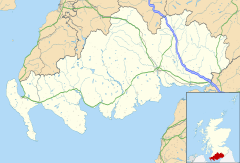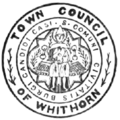Whithorn facts for kids
Quick facts for kids Whithorn |
|
|---|---|
| Population | 750 (2020) |
| OS grid reference | NX445405 |
| • Edinburgh | 97 mi (156 km) |
| • London | 285 mi (459 km) |
| Council area | |
| Lieutenancy area | |
| Country | Scotland |
| Sovereign state | United Kingdom |
| Post town | NEWTON STEWART |
| Postcode district | DG8 |
| Dialling code | 01988 |
| Police | Dumfries and Galloway |
| Fire | Dumfries and Galloway |
| Ambulance | Scottish |
| EU Parliament | Scotland |
| UK Parliament |
|
| Scottish Parliament |
|
Whithorn (pronounced 'HWIT-horn') is a historic town in Scotland. It's located in Dumfries and Galloway, about 10 miles (16 km) south of Wigtown. Whithorn is famous because it was home to the very first recorded Christian church in Scotland. This church, called Candida Casa (meaning 'White House'), was built by Saint Ninian around the year 397.
Contents
What's in a Name? The Story of Whithorn

The name "Whithorn" has a cool history! Long ago, around the late 300s, a saint named Ninian built a church nearby. This church was made of stone and lime, which made it look white. So, people called it Candida Casa, meaning "White House" in Latin.
Later, the Anglo-Saxons, who were people from what is now Germany and Denmark, came to the area. They called the town Hwit Ærn, which also means "white house" in their language. Over time, Hwit Ærn became the modern name "Whithorn."
Ninian dedicated his church to his teacher, Martin of Tours. When Ninian passed away in 432, he was buried right there in the church.
Whithorn's Ancient Past
Whithorn has a very long and interesting history! In the 700s, a monastery and a church area (called a diocese) were set up here by the Anglo-Saxons. Some people think this might have started even earlier, around the 500s, as a large monastery known as Magnum Monasterium.
Later, in the 1100s, the area became important again as the center of the See of Galloway. This was a special church region. The main church building, called Whithorn Priory, is mostly in ruins now. But it was once a very important place for pilgrimage (religious journeys) in medieval Scotland. People would travel from far away to visit the shrine of St. Ninian there.
Today, you can visit a museum in Whithorn. It shows many cool things found during recent digs at the old church site. There's also an old gateway with the King of Scots' symbol that leads to the priory ruins. Inside, you'll find the 1800s parish church and a museum with carved stones. This collection of early medieval stones is one of the biggest in Scotland. It includes the oldest Christian memorial still around in the country: the 5th-century 'Latinus Stone'. The museum was updated in 2005 and is a great place to learn about the past.
The Whithorn Crozier: A Special Staff
One of the most amazing items found at the Whithorn site is the Whithorn crozier. A crozier is a special staff shaped like a shepherd's crook that bishops carry. This one is covered in gold and beautiful enamel designs. It's a fantastic example of a type of art called champlevé enamel, which was popular in England in the late 1100s. This crozier was made around 1175.
The Whithorn crozier is now kept at the National Museums of Scotland. But every summer, it's loaned to the Whithorn Trust Visitor Centre, so you can see it right where it was found! Experts believe the crozier was buried with the body of Simon de Wedale, who was one of the Bishops of Whithorn.
Churches in Whithorn
Whithorn has a couple of interesting churches:
- St Martin and St Ninian Catholic Church: This church on George Street was built in 1959–60. It was designed by a famous architect named Harry Stuart Goodhart Rendel. The inside of the church was changed a bit later to fit new church practices. You can see a carved crucifix by Hew Lorimer on the outside wall. This church is considered a historic building.
- St Ninian's Priory Church: This is a Church of Scotland building. It was built in 1822 using stones from the old medieval Whithorn Priory. A tower was added in the mid-1800s, and a porch was built in 1914.
Whithorn's Location and Connections
Whithorn is connected to the sea through a nearby port called the Isle of Whithorn. This isn't an island, but a small peninsula. In the Middle Ages, many pilgrims would arrive here by boat. The 1200s Saint Ninian's Chapel marked the spot where these pilgrims would come ashore. You can still see the roofless remains of this chapel today.
About 1 mile (1.6 km) west of Whithorn, you can find Rispain Camp. This was a settlement from the 1st century, a very long time ago! Both the chapel and Rispain Camp are looked after by Historic Environment Scotland.
Whithorn's Railway History
Whithorn once had its own train station. Passenger trains stopped running in 1950. Then, in 1964, freight services (trains carrying goods) were also stopped as part of big changes to the railway system. The train tracks were removed in April 1965.
Famous People from Whithorn
Many interesting people have connections to Whithorn:
- Charles Lockhart (1818–1905): Born near Whithorn, he became a very important person in the oil industry. In 1874, he helped start the Standard Oil Company with John D. Rockefeller, which later became Esso.
- Alastair Reid (1926–2014): This poet and scholar was born in Whithorn. He was known for his fun poems and for translating the works of famous South American poets like Jorge Luis Borges and Pablo Neruda.
- George Dickie (1912–1951): Born and raised in Whithorn, George fought in the Spanish Civil War (1936–38) against the fascist forces. A special plaque honors him on the building where he once worked. His story is told in a book called Geordie's Story: A Life of Jack Brent.
- Jeannie Donnan (1864–1942): Known as "The Galloway Poetess," Jeannie lived on George Street in Whithorn. She wrote local poetry that was published in several books and in the Galloway Gazette newspaper.
Images for kids
See Also
- Whithorn (Parliament of Scotland constituency)
- Isle of Whithorn








